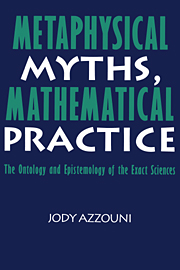PART I - MATHEMATICAL PRACTICE AND ITS PUZZLES
Published online by Cambridge University Press: 15 December 2009
Summary
It seems clear that what is needed in Philosophy of Mathematics is work that is philosophical and not primarily technical.
Hilary PutnamMetaphysical Inertness
Here is a portrait of mathematical practice: The mathematician proves truths.
In bygone days, such truths were couched in the vernacular augmented with a small list of technical terms. The proofs were (more or less) detailed arguments; these arguments were (more or less) valid, where validity was understood informally according to the standards of the time; and these arguments were surveyable, provided one had the training.
How different things are these days is a bit hard to determine. Most proofs are still detailed (and surveyable) arguments couched in the vernacular augmented with a (somewhat larger) list of technical terms. Some proofs, however, are the results of computer calculations and are not surveyable. First-order canons of validity have been formalized, but this has been achieved by constructing first-order formal languages that (theoretically speaking) seem able to replace natural languages as the medium for mathematics.
However, there is some debate about the faithfulness of the firstorder mirror of mathematics. One problem is that many mathematical notions are simply not first-order definable, ‘finite’ and ‘infinite’ being obvious examples. Another (related) problem is the Löwenheim–Skolem theorem: Significant first-order theories admit of unintended nonisomorphic models.
For these and other reasons, some philosophers and logicians think that the line between logic and mathematics should not be drawn at the boundary of first-order logic.
- Type
- Chapter
- Information
- Metaphysical Myths, Mathematical PracticeThe Ontology and Epistemology of the Exact Sciences, pp. 1 - 76Publisher: Cambridge University PressPrint publication year: 1994



